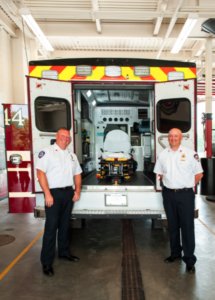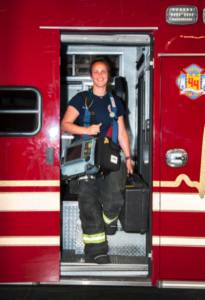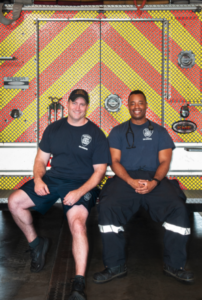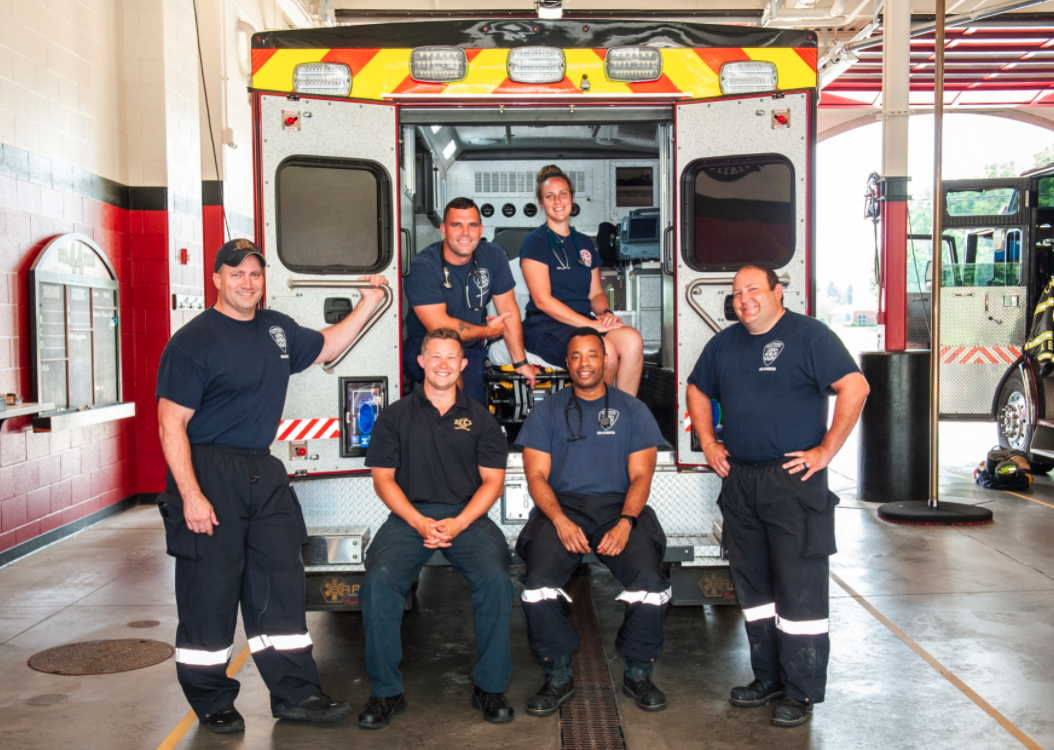Carmel EMS Leaders Talk Safety and Preparation
Writer / Heather Hunter
Photographer / Linda Oldiges
 Jon Alverson, division chief of Carmel Fire Department Emergency Medical Services (EMS), and Andrew Young, EMS training captain, have been a team for more than three years. Along with their co-workers, they respond to calls from Carmel citizens in need of emergency medical assistance. Both men love their work.
Jon Alverson, division chief of Carmel Fire Department Emergency Medical Services (EMS), and Andrew Young, EMS training captain, have been a team for more than three years. Along with their co-workers, they respond to calls from Carmel citizens in need of emergency medical assistance. Both men love their work.
“We signed up to help people, and when those calls come in, it’s a chance to engage, to use our skills, and hopefully create a positive outcome for the patient,” Alverson says. “Our community is great to us. It’s an opportunity for us to be great for them.”
Alverson is in his 15th year with the Carmel Fire Department, and Young is in his 17th. Both belong to the 30% of the department’s EMS personnel who are licensed paramedics. Additionally, every Carmel firefighter is an emergency medical technician, qualified to provide medical assistance at the scene of an emergency. They work as a team to respond to calls across the city.
Among the calls Carmel EMS has received in 2021, 54% are from senior citizens (those aged 65 and above).
“Because of the density of care facilities here, we have a high run-load in that demographic,” Young says. “The typical department, though, is still above 35% to 40%. Seniors are going to be a high volume of patients wherever you go.”
When it comes to seniors, Carmel EMS responds mostly to falls. Sometimes patients call because of chest pains or other difficulties. No matter the situation, the team comes prepared. Callers can expect a fire engine and an ambulance, manned with several firefighters and EMTs. Individuals should not be alarmed by the number of providers, Alverson says. From a scrape to a broken bone, each call gets the same response.
“We don’t know what we’re getting into before we come, so we want to be sure we have the resources to handle it,” Alverson says.
If you’re able to prepare for EMS to arrive, it’s helpful to lock up your pets and create an easy way for the team to get inside.
“Have someone unlock the door, or someone stand outside to wave us in if you can,” Alverson says.
Once they arrive, the team splits up to ask the patient some questions, check vitals, and clear a path to the door for a stretcher if necessary. Each EMT knows their role, and they’ll do their best to make patients comfortable while gathering information.
If you aren’t able to prepare, don’t worry.
“Do your best to remain calm,” Alverson says. “We’re there to take care of you. We will take care of the stuff on the back end, and we’ll lock the house up when we leave.”
Under current COVID conditions, EMS can bring a loved one along in the ambulance. If loved ones choose to drive themselves to the hospital, Young says not to rush.
“I always tell them, ‘Take your time, stay calm. Don’t tail us if we have the lights and sirens on. Be patient. Your loved one is in very good hands,’” he says.
The most important information seniors can prepare ahead of time is medical information. The department provides special refrigerator magnets, which can be filled out with medical information, for as many seniors as they can. If you’re lacking one, you can also use a piece of paper to record your recent medical history, medications, allergies, preferred hospital, and emergency contacts. EMTs are trained to look for both magnets and papers on senior citizens’ refrigerators.
Although they hope it isn’t necessary, Alverson and Young agree that it’s also important to keep advance-directive forms on hand.
“We want to make sure that the person gets the care they want to receive if they are unconscious and they aren’t able to communicate that decision,” Young says. “We’re bound legally to act in the best interest of the patient if we don’t know what they want.”
 The form they recommend is the Indiana POST (physician orders for scope of treatment) form, which seniors can fill out with the help of their physician. If you have a POST form or a do-not-resuscitate declaration, make sure a family member or trusted friend knows its location and can pass it on to your care providers.
The form they recommend is the Indiana POST (physician orders for scope of treatment) form, which seniors can fill out with the help of their physician. If you have a POST form or a do-not-resuscitate declaration, make sure a family member or trusted friend knows its location and can pass it on to your care providers.
Despite the serious nature of their work, the crew keeps things light when they can.
“In a legitimate situation we’re going to give calm reassurance, and be efficient in getting you transported and getting you to definitive care,” Alverson says.
They also know how and when to cheer up a patient.
“There are many times when we have fun patients,” Young says. “If the situation dictates it, you may see some humor from our guys. That realness and that humor can take a situation that is potentially one of the worst days of [the patient’s] life and alleviate that stress. It creates a connection between the provider and the patient.”
Today, one of the department’s top priorities is to prevent emergency situations before they happen.
“We realized there was a gap in health care,” Alverson says. “The fire department is traditionally a reactive service. We wait for a run and we go. Then they started fire prevention. We’ve reached that time in health care. How can we provide education in our community so they can prevent 911 calls?”
For seniors, Alverson and Young stress the importance of displaying an emergency contact, and carrying a cell phone or emergency activation pendant. They also recommend that all seniors get a safety assessment of their homes. To help, the department has a resource called a Mobile Integrated Health Program (MIHP). Through the MIHP, a dedicated provider can conduct a fall-prevention assessment in your home. They’ll look for things like cords, rugs, oxygen tubing and other trip hazards that may be overlooked.
The MIHP professional, which could be one of a few paramedics, also assists seniors with medical needs.
 “If you’re confused about some of your medications, he can provide resources,” Alverson says. “If you need a bar in your shower, he can come out and recommend different organizations that can provide those things and guide you to appropriate contractors.”
“If you’re confused about some of your medications, he can provide resources,” Alverson says. “If you need a bar in your shower, he can come out and recommend different organizations that can provide those things and guide you to appropriate contractors.”
The MIHP can also help seniors with food needs, and provide resources for independent- and assisted-living facilities.
People of all ages can help by getting a cardiopulmonary resuscitation (CPR) certification. By learning basic, hands-only CPR and how to use an automated external defibrillator, bystanders can buy time for people in medical emergencies while EMS gets to the scene.
“It’s truly life-saving,” Young says. “Our cardiac arrest patients with better outcomes are the ones who have had CPR before we got there.”
Beginning in 2022, once they’ve moved into their new fire station, the department will offer monthly classes for anyone interested. In the meantime, they offer local classes. Interested parties can also get a certification online through the American Heart Association.
Whether it’s preventative care or emergency services, Carmel EMS is always ready to help.
“If you have to ask yourself whether it’s an appropriate situation to call us, then call us,” Alverson says. “Best case, we show up, we do a quick check of the patient, they don’t want to go to the hospital, they sign a document, and we go back to the fire station.”
“We want to help people,” Young adds. “If you’re calling 911, you’re having a bad day. Being able to be the person that shows up and maybe even puts a smile on that person’s face, it really is a wonderful feeling. It’s nice to be able to do that for people in our community.”
To learn more about Carmel EMS, visit carmel.in.gov. For more info on MIHP resources for seniors, email MIHP@carmel.in.gov or call 317-571-2606.






